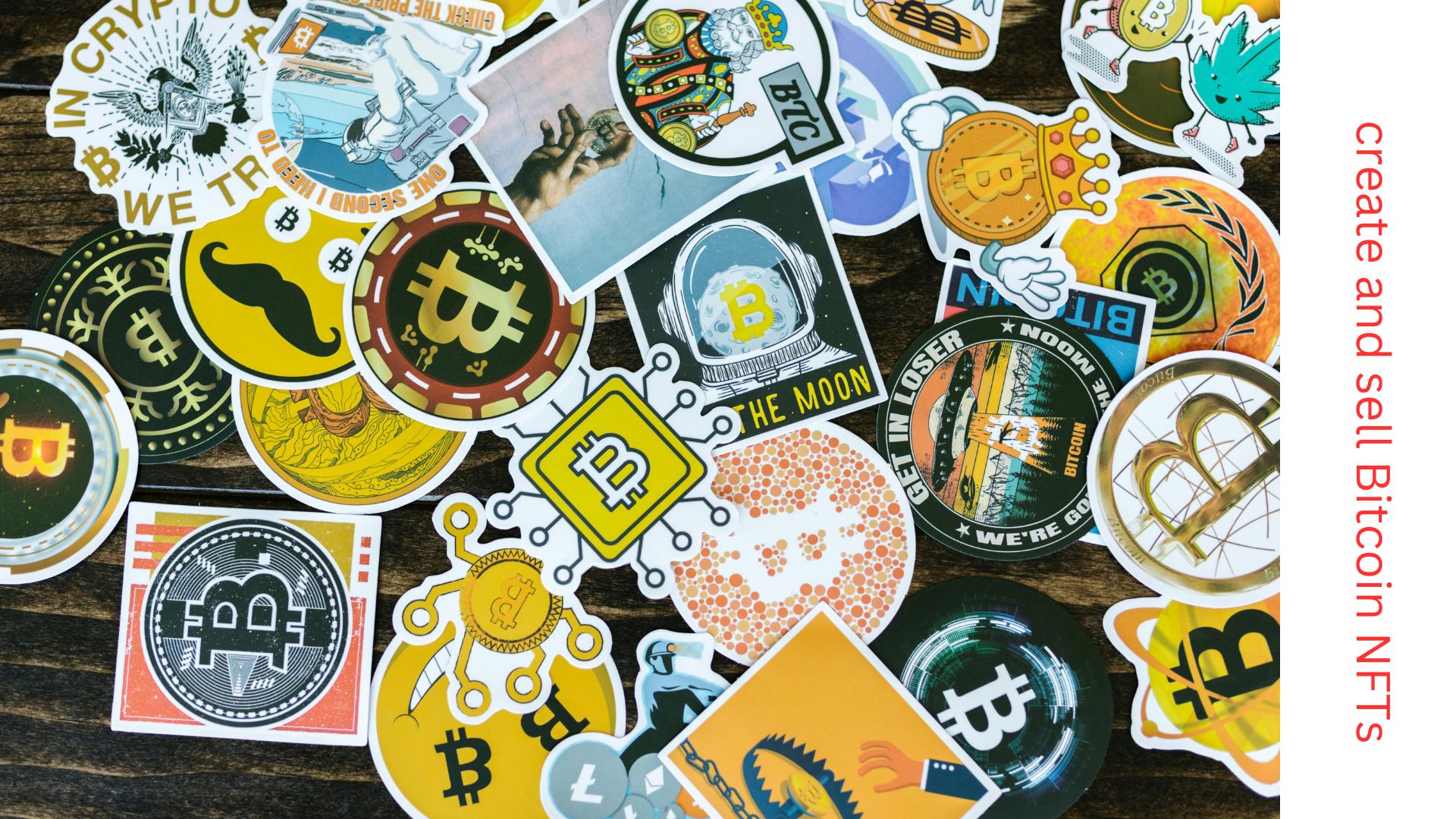How to Create and Sell Bitcoin NFTs: A Step-by-Step Guide for 2024
Bitcoin nonfungible tokens (NFTs) have rapidly seized the crypto world’s interest, presenting fresh opportunities for blockchain and digital art aficionados alike. Since their meteoric rise in 2020, NFTs have predominantly been minted and traded on Ethereum-based platforms, alongside other blockchains like Cardano and Solana.
However, a new protocol named Ordinals emerged in January 2023, led by former Bitcoin Core contributor Casey Rodarmor. Leveraging the 2021 Bitcoin Taproot upgrade, Ordinals extends the cryptocurrency’s capabilities, enabling the creation of on-chain Bitcoin-native NFTs.
The Taproot upgrade facilitated an expansion of the base layer’s block capacity by reducing transaction size, optimizing data usage, and promoting the adoption of smart contracts on Bitcoin. This enhancement significantly broadens the range of transactions feasible on Bitcoin, encompassing applications in decentralized finance (DeFi) and NFTs.
As of February 2023, Yuga Labs, the world’s largest NFT issuer, had already introduced TwelveFold, a new NFT collection issued on Bitcoin. This move not only signals Yuga Labs’ endorsement of Bitcoin-based NFTs but also underscores their potential for widespread adoption and success in the market.
Here’s what you need to know about Bitcoin NFTs, including how they differ from the most popular alternative, Ethereum-based platforms, in terms of creation and sale.

What are Ordinals?
Ordinals are sequential numbers assigned to individual satoshis (sats), the smallest unit of Bitcoin (BTC), based on the ordinal theory that categorizes them by the order in which they were mined. The very first satoshi in the initial block is assigned ordinal number 0, the second satoshi receives ordinal number 1, and so on. This sequence continues until the last satoshi of the block, which is assigned ordinal number 4,999,999,999.
Colored coins pioneered the concept in 2012 by repurposing crypto assets to represent tangible assets through the addition of metadata. Counterparty also attempted to embed data into Bitcoin transactions but introduced its own XCP token for specific functionalities, categorizing it as an altcoin rather than a second-layer extension of Bitcoin.
The ordinal theory enhances stashes with numismatic value, allowing them to be collected and traded as rare items. Each stash is uniquely identified and can store meaningful arbitrary data, such as images, text, or videos, within Bitcoin transactions recorded permanently on the main blockchain. This data can be viewed using Ordinals-compatible wallets like Sparrow and online explorers.

Inscriptions
The process of assigning assets to individual satoshis is known as inscription. Inscriptions are digital artifacts inherent to the Bitcoin blockchain, akin to digital relics.
These inscriptions are fully on-chain, eliminating the need for sidechains or separate tokens. The Ordinals protocol allows sats to be inscribed with content, indexed, and accessed through explorers and wallets that rely on Bitcoin Core for private key management and transaction signing.
Ord enables the tracking of specific stashes and their ordinal numbers, viewable through the Ordinals explorer. Unlike traditional NFTs that rely on off-chain content stored on the InterPlanetary File System (IPFS), inscriptions benefit from Bitcoin’s immutability and security. They are permissionless and non-consumable digital artifacts, as they can be transferred or sold without ongoing royalties.
How An ordinal NFT to generate Bitcoin NFTs
The Ordinals ecosystem is in full development, but its accessibility continues to be on a two ways that are primary mint.
- The first method to inscribe Bitcoin Ordinals involves technical skills, requiring the operation of a full Bitcoin node and the installation of Ord on this node to inscribe satoshis into an Ordinals wallet for creating Bitcoin Ordinals NFTs. Two types of Bitcoin wallets can handle Ordinals; both must be Taproot-compatible and have “coin control” capability to prevent accidental spending of satoshis as network fees or in subsequent transactions. The Sparrow wallet is specifically designed to receive Ordinals and prevent accidental spending. However, using it does not require running a full node. Here’s how to set up the Sparrow wallet.
- An Ord wallet necessitates running a full node with a capacity of 500GB. It allows you to create inscriptions and lock the inscribed satoshis to prevent accidental spending within the Sparrow wallet. Here’s how to set it up.
an Ord wallet.
Regardless of the wallet you choose to use, always ensure you have some Bitcoin available to cover the transaction fees. This is essential for completing transactions and interactions on the Bitcoin network.
- The second method is more straightforward and involves using a no-code tool such as Gamma or Ordinalsbot.com to inscribe your ordinal NFT. Here’s how to mint your Ordinal on Gamma:
- Select the type of file you’d like to use to mint your Bitcoin NFT.
- Upload the necessary file from your computer.
- Set the transaction fee based on how quickly you’d like your Ordinal to be minted.
- Copy and paste the Bitcoin address where the digital artifact will be sent, which must be a Taproot-compatible ordinal address.
- Wait for the NFT to be minted. The duration of this wait depends on the fee you paid for the transaction to be processed and could range from hours to days. You can track the minting status through the link you’ll receive via email.
View your minted Ordinal on Ordinals Viewer.
How to trade Ordinals
While infrastructure and marketplaces for trading Bitcoin Ordinals are being developed, these digital artifacts are currently traded peer-to-peer through over-the-counter (OTC) transactions in dedicated Discord servers. Intermediaries often use escrow services, and transactions are tracked using tools like Google Sheets.
Compared to the more popular NFTs traded on Ethereum and other blockchains, Bitcoin Ordinals trading appears to be a more traditional approach. However, this hasn’t dampened interest in Bitcoin NFTs, with hundreds of thousands of new digital artifacts minted within just a few weeks of launch.
The Ordinals marketplace operates entirely on a trustless basis, utilizing secure Partially Signed Bitcoin Transactions (PSBT) technology. This allows users to sign transactions easily, even in cold storage, enabling atomic swaps with no intermediary and a low fee of 2.7%. Additionally, a method to verify creators is being developed, which will include creator royalties of 4.2%.
- To acquire Bitcoin Ordinals, you’ll need a Taproot-compatible wallet such as the Ordinals wallet, Xverse, or Hiro wallets. The Ordinals wallet is particularly user-friendly, and others follow a similar process.
- Create an account with your chosen wallet provider, secure your seed phrase, and deposit funds into the wallet.
- Once your wallet is funded, select the Bitcoin Ordinals you wish to purchase and click “Buy Now” to complete the transaction securely.
Once the transaction is completed, the purchased Bitcoin Ordinals will be added to your wallet, ready for you to manage or trade as you choose.
How to sell Bitcoin NFTs
- To purchase Bitcoin Ordinals, start by selecting a Bitcoin Taproot-compatible wallet and downloading it.
- Create an account within the wallet, secure your seed phrase securely, and prepare to upload your inscription. Transaction fees will vary based on the file size and desired speed of transaction completion.
- After your file has been successfully inscribed onto the blockchain, you can view it on the Ordinals.com inscriptions page to verify its status and details.
accidentally spend them again

You’ll spend them have to use OTC that is peer-to-peer
market usually, the Bitcoin Ordinals Discord server, to sell
your inscription.
It is crucial to exercise caution when engaging in these transactions. The unregulated nature of peer-to-peer over-the-counter (OTC) markets makes them fertile ground for scammers looking to exploit the current Bitcoin NFT trend.
- Choose a digital wallet
- Set up your digital wallet
- Add cryptocurrency to your wallet
- Connect your wallet to an NFT platform
- Upload the file for your NFT
- Set up an auction or listing
- Add a description
- Ordinals vs. traditional NFTs
- Bitcoin Ordinals, as created by Casey Rodarmor, differentiate themselves from traditional Ethereum-based NFTs primarily in their immutability and on-chain nature. Rodarmor defines Bitcoin NFTs as authentic digital artifacts that reside permanently on the blockchain, enjoying inherent security and permanence. One of the key distinctions is that Ordinals are immutable by nature, meaning once inscribed, they cannot be altered or deleted. In contrast, Ethereum-based NFTs can potentially be changed or deleted by the contract owner, although achieving true immutability requires rigorous auditing and understanding of the Ethereum Virtual Machine (EVM) and Solidity programming language. Therefore, Bitcoin Ordinals offer a more straightforward path to creating and maintaining immutable digital assets on the blockchain.
Bitcoin inscriptions are distinctive in their on-chain content, ensuring durability and making loss virtually impossible. This characteristic adds to their scarcity, as inscriptions require fees that align with the size of the content being stored. In contrast, Ethereum NFT content often resides off-chain, stored on platforms like IPFS, which introduces the risk of potential loss.
Bitcoin inscriptions are inherently more secure due to the robust security of the blockchain itself. These inscriptions can be transferred using Partially Signed Bitcoin Transactions (PSBT), eliminating the need for intermediaries like marketplaces or exchanges to facilitate transactions. In contrast, Ethereum NFTs often involve granting unlimited permissions to intermediary platforms, and navigating complex smart contracts can be daunting for non-technical users interested in trading digital art.
Unlike NFTs, which are minted as entirely new tokens, Ordinals inscribe the raw file directly onto the sats of the Bitcoin blockchain.
Bitcoin NFTs controversy
The introduction of the Ordinals protocol has sparked significant debate within the NFT community. It raises fundamental questions about Bitcoin’s role: whether it should solely serve as a form of currency or expand its utility with new applications like NFTs. Some argue that protocols like Ordinals could potentially strain the Bitcoin network
The Bitcoin blockchain has historically been oriented towards processing payment transactions, largely due to its constrained block size and network architecture. This setup has led to the development of solutions that build additional layers on top of the blockchain, enhancing its programmability and scalability.
The recent excitement surrounding Ordinals has sparked considerable debate within the Bitcoin community. Many are concerned that it could divert attention from Bitcoin’s primary role as a medium of exchange, questioning whether Ordinals effectively utilize block space. Given that Ordinals can encompass images, audio clips, and even games, they inevitably consume space that could otherwise be used for financial data, potentially slowing down on-chain confirmations. This debate underscores the tension between expanding Bitcoin’s utility through new use cases and maintaining its efficiency as a decentralized digital currency.

Bitcoin’s fungibility
Bitcoin’s fungibility, a fundamental property of money, faces challenges due to Ordinals. This is because inscriptions are imprinted on individual satoshis, creating rare units similar to numismatic coins or rare physical objects sought after by collectors. Each ordinal satoshi becomes a unique identity that can be tracked, transferred, and imbued with meaningful information like text or images, effectively turning it into a de facto NFT. The traditional view of all satoshis as equal loses significance in this context, potentially altering the fungibility of Bitcoin as each satoshi gains distinct characteristics akin to collectible items rather than purely fungible currency units.
full node incurs costs
Can NFT be created for Bitcoin?
Can you sell NFTs for Bitcoin?
Is creating your own NFT profitable?
How do I create an NFT and make money?
car accident lawyer,car accident,texas car accident lawyer,car accident attorney,texas car accident attorney,lawyer,texas,houston car accident lawyer,car accident lawyer houston texas,texas accident lawyer,accident lawyer,truck accident,personal injury lawyer,truck accident lawyer,motorcycle accident,car accident claim,auto accident,dallas car accident lawyer,houston truck accident lawyer,car accidents,texas truck accident lawyer
houston car accident lawyer,car accident,car accident lawyer,houston car accident lawyers,houston car accident attorney,car accident attorney,car accident lawyer houston,attorney,truck accident attorney,car accident lawyer houston texas,houston truck accident lawyer,best houston car accident lawyer,car accident lawyers,car accident attorney houston,car accident attorney houston tx,car accident attorneys,best car accident lawyer,texas,accident
biker attorney,biker attorneys,motorcycle lawyer,motorcycle lawyers,car accident lawyer advice,lawyer car accident,lawyer for car accident,lawyers car accidents,lawyer for a car accident,lawyers car accident,car accident lawyer,lawyer accident car,lawyers for car accident,car accidents lawyer,car accident lawyers,car accidents lawyers,lawyers for car,
texas car accident lawyer texas accident lawyer car accident attorney houston, texas awyers for car accident claim texas accident attorney LAWYER











